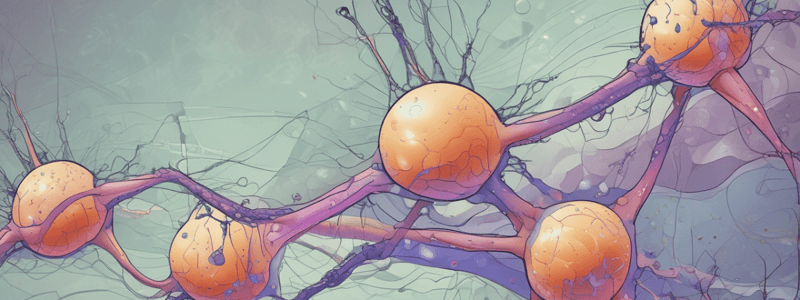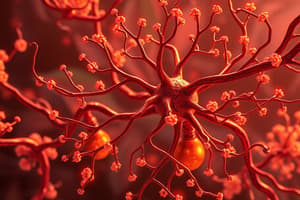Podcast
Questions and Answers
What is one result of repetitive stimulation in the presence of non-depolarizing block monitoring?
What is one result of repetitive stimulation in the presence of non-depolarizing block monitoring?
- Tetanic contraction
- Depolarization
- Fade (correct)
- Hyperpolarization
How do volatile anesthetics affect neuromuscular blockers?
How do volatile anesthetics affect neuromuscular blockers?
- Stabilization
- Inhibition
- Neutralization
- Potentiation (correct)
Why is clinical assessment of recovery from neuromuscular blockade considered unreliable?
Why is clinical assessment of recovery from neuromuscular blockade considered unreliable?
- Results in residual paralysis
- Increases morbidity
- Prolongs effect
- Subjective nature (correct)
What is recommended to prevent residual paralysis and associated complications when using a nerve stimulator?
What is recommended to prevent residual paralysis and associated complications when using a nerve stimulator?
Why is monitoring at particular sites for neuromuscular block onset and recovery considered unreliable?
Why is monitoring at particular sites for neuromuscular block onset and recovery considered unreliable?
How do anticholinesterases work in the context of non-depolarizing neuromuscular blockers?
How do anticholinesterases work in the context of non-depolarizing neuromuscular blockers?
What is the purpose of pairing anticholinesterases with an antimuscarinic for neuromuscular blockade reversal?
What is the purpose of pairing anticholinesterases with an antimuscarinic for neuromuscular blockade reversal?
What is the key reason for pairing anticholinesterases with antimuscarinic drugs during neuromuscular blockade reversal?
What is the key reason for pairing anticholinesterases with antimuscarinic drugs during neuromuscular blockade reversal?
What is the primary mechanism of action for succinylcholine and non-depolarizing neuromuscular blockers?
What is the primary mechanism of action for succinylcholine and non-depolarizing neuromuscular blockers?
Which type of neuromuscular blocker is most likely to exhibit a fade on train-of-four monitoring during typical block monitoring?
Which type of neuromuscular blocker is most likely to exhibit a fade on train-of-four monitoring during typical block monitoring?
What is one of the significant side effects associated with succinylcholine but not with non-depolarizing neuromuscular blockers?
What is one of the significant side effects associated with succinylcholine but not with non-depolarizing neuromuscular blockers?
How do non-depolarizing neuromuscular blockers result in neuromuscular block?
How do non-depolarizing neuromuscular blockers result in neuromuscular block?
Which type of neuromuscular blocker is contraindicated for routine use in otherwise healthy children?
Which type of neuromuscular blocker is contraindicated for routine use in otherwise healthy children?
What may result from an increase in the 'immature' forms of NAChRs following administration of a depolarizing NMB?
What may result from an increase in the 'immature' forms of NAChRs following administration of a depolarizing NMB?
What is the primary effect of sugammadex on aminosteroidal neuromuscular blockers like rocuronium and vecuronium?
What is the primary effect of sugammadex on aminosteroidal neuromuscular blockers like rocuronium and vecuronium?
Which of the following is a potential consequence of inadequate reversal of muscle relaxant at the end of surgery?
Which of the following is a potential consequence of inadequate reversal of muscle relaxant at the end of surgery?
What type of receptors are predominantly expressed in mature, innervated muscle at the end-plate region?
What type of receptors are predominantly expressed in mature, innervated muscle at the end-plate region?
In which circumstance would there be an increase in immature acetylcholine receptors in response to decreased stimulation of the neuromuscular junction?
In which circumstance would there be an increase in immature acetylcholine receptors in response to decreased stimulation of the neuromuscular junction?
Which disease state may lead to hyperkalemia following the use of succinylcholine due to upregulation of immature α7 nicotinic Ach receptors?
Which disease state may lead to hyperkalemia following the use of succinylcholine due to upregulation of immature α7 nicotinic Ach receptors?
What is a characteristic of succinylcholine Phase II block that distinguishes it from Phase I block?
What is a characteristic of succinylcholine Phase II block that distinguishes it from Phase I block?
How does succinylcholine primarily act on the neuromuscular junction to induce muscle paralysis?
How does succinylcholine primarily act on the neuromuscular junction to induce muscle paralysis?
Which of the following statements about sugammadex is most accurate?
Which of the following statements about sugammadex is most accurate?
What is the recommended waiting period before re-administering rocuronium after reversal with sugammadex?
What is the recommended waiting period before re-administering rocuronium after reversal with sugammadex?
How does sugammadex reverse neuromuscular blockade at the neuromuscular junction (NMJ)?
How does sugammadex reverse neuromuscular blockade at the neuromuscular junction (NMJ)?
What is the dosing recommendation for sugammadex when reversing profound neuromuscular blockade?
What is the dosing recommendation for sugammadex when reversing profound neuromuscular blockade?
Which factor may lead to prolonged recovery of neuromuscular function with sugammadex?
Which factor may lead to prolonged recovery of neuromuscular function with sugammadex?
Regarding side effects, which statement accurately reflects the information provided about sugammadex?
Regarding side effects, which statement accurately reflects the information provided about sugammadex?
What role does sugammadex have in reducing postoperative nausea and vomiting (PONV) compared to anticholinesterases?
What role does sugammadex have in reducing postoperative nausea and vomiting (PONV) compared to anticholinesterases?
What is one significant consideration regarding the expense of sugammadex?
What is one significant consideration regarding the expense of sugammadex?
What is defined as partial paralysis in the context of the provided text?
What is defined as partial paralysis in the context of the provided text?
Which patient group is more likely to experience partial paralysis according to the text?
Which patient group is more likely to experience partial paralysis according to the text?
What conditions are associated with prolonged use of neuromuscular blockers according to the text?
What conditions are associated with prolonged use of neuromuscular blockers according to the text?
When is neuromuscular monitoring recommended in the ICU according to the text?
When is neuromuscular monitoring recommended in the ICU according to the text?
In which situations are adequate intubating conditions not always attainable without neuromuscular blocker usage?
In which situations are adequate intubating conditions not always attainable without neuromuscular blocker usage?
What medical condition is associated with more common occurrence of partial paralysis as per the text?
What medical condition is associated with more common occurrence of partial paralysis as per the text?
What effect does high-dose steroid administration have on partial paralysis according to the text?
What effect does high-dose steroid administration have on partial paralysis according to the text?
What should be allowed to monitor periodic return of muscle function when neuromuscular blockade is necessary in the ICU, according to the text?
What should be allowed to monitor periodic return of muscle function when neuromuscular blockade is necessary in the ICU, according to the text?
Flashcards are hidden until you start studying
Study Notes
Neuromuscular Blockers
- Neostigmine: dose 20-70 μg/kg (supplied as 1.0 mg/ml), paired with glycopyrrolate (20-25% of neostigmine dose)
- Edrophonium: dose 0.5-1.0 mg/kg (supplied as 10 mg/ml), paired with atropine
- Sugammadex: a selective relaxant binding agent (SRBA), reverses effects of rocuronium and vecuronium, highly water soluble, minimal metabolism, excreted by kidneys, T1/2 ~100 minutes
Sugammadex
- Dosing and Onset:
- Moderate block (TOFC > 2): 2 mg/kg, reversal to TOF >0.9 in 2-4 minutes
- Deep block (PTC >1, TOF = 0): 4 mg/kg, mean reversal time = 2.9 minutes
- Profound block (PTC = 0, TOF = 0): 16 mg/kg, reversal time = 2-4 minutes
- Side Effects:
- Hemodynamic: none
- Hypersensitivity reactions (anaphylaxis): 1:3500 – 1:20,000
- Coagulation: minimal, brief increase in PT and PTT lasting < 60 minutes
- Hypothermia: mild, increases reversal time by < 1 minute
- Interference with oral contraception: equivalent to missing one dose, alternative means of birth control suggested for one week
Reversal of Neuromuscular Blockade
- Anticholinesterases: paired with an antimuscarinic to prevent muscarinic effects, increases ACh levels at the NMJ to compete with NMB drug
- Sugammadex: alternative to anticholinesterases, binds to and encapsulates steroidal NMBs, reducing free NMB concentration in plasma, concentration gradient favors NMB movement from NMJ to plasma, reversing blockade
Neuromuscular Blockade
- Fade on Train-of-Four (TOF) monitoring: characteristic of non-depolarizing NMBs, not seen with succinylcholine
- Post-tetanic Facilitation: characteristic of non-depolarizing NMBs, not seen with succinylcholine
- Residual Neuromuscular Blockade: more common in asthmatic patients receiving high-dose steroids, renal failure, and with steroidal NMBs
Monitoring Neuromuscular Blockade
- Clinical Assessment: unreliable, predisposes to residual postoperative neuromuscular blockade and increased morbidity
- Nerve Stimulator: results in marked increase in likelihood of residual paralysis and complications when used without objective measurement
- Monitoring Sites: different muscles have varying sensitivity to and recovery from NMBs, monitoring at specific sites may under- or overestimate onset and recovery
Studying That Suits You
Use AI to generate personalized quizzes and flashcards to suit your learning preferences.




